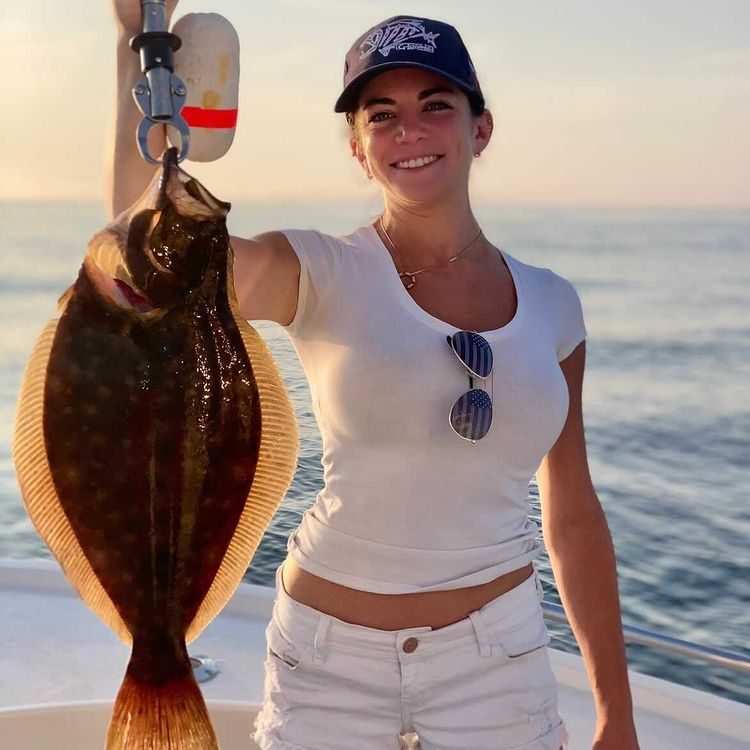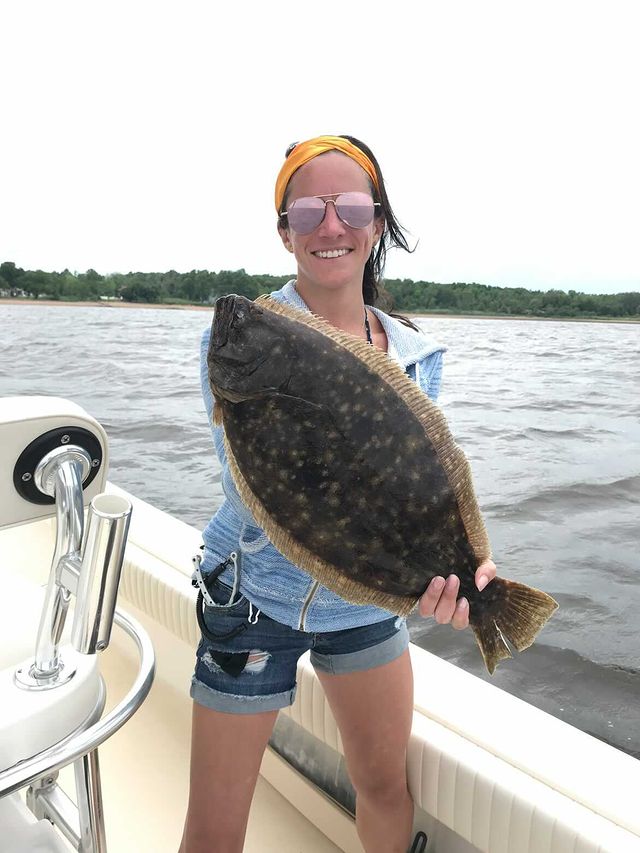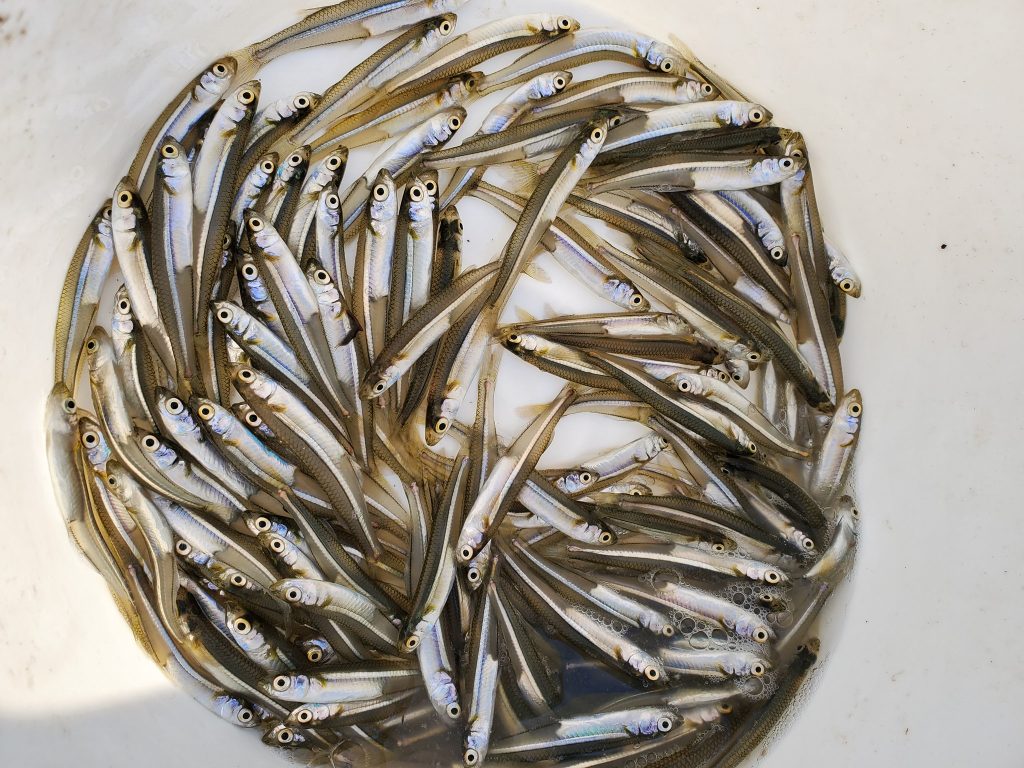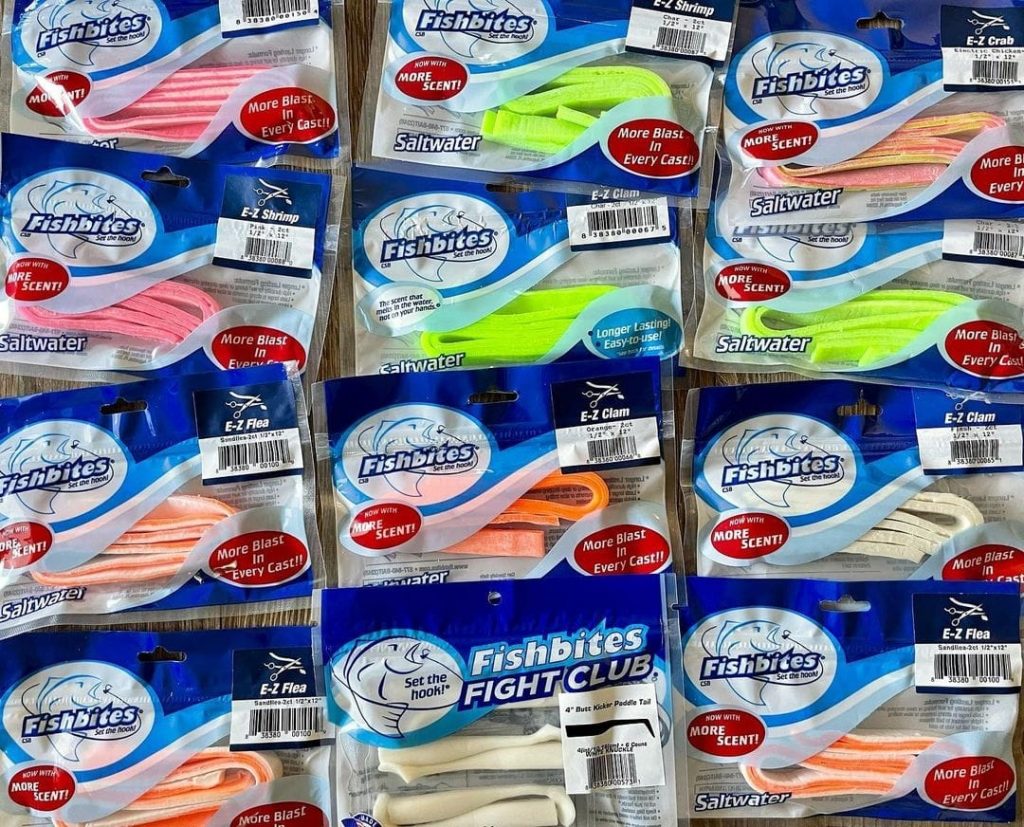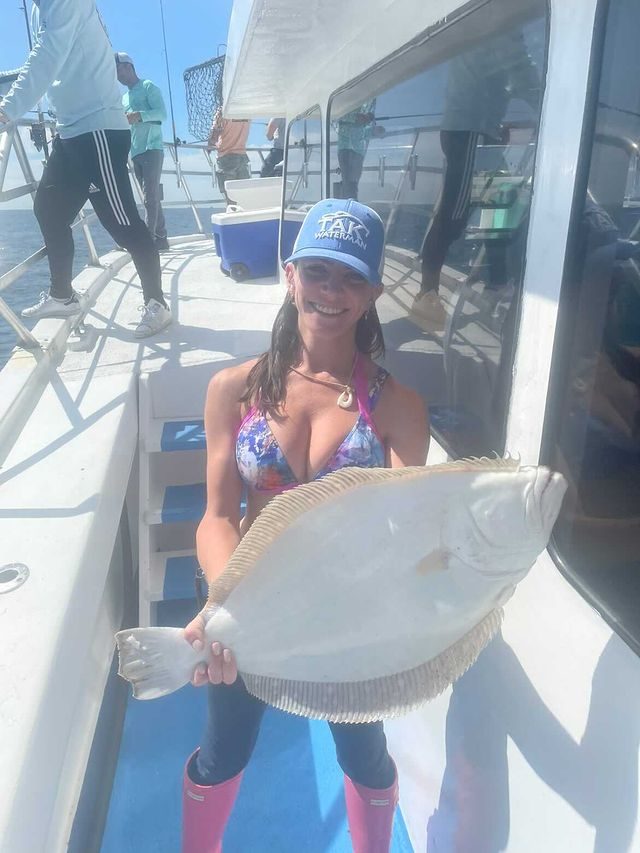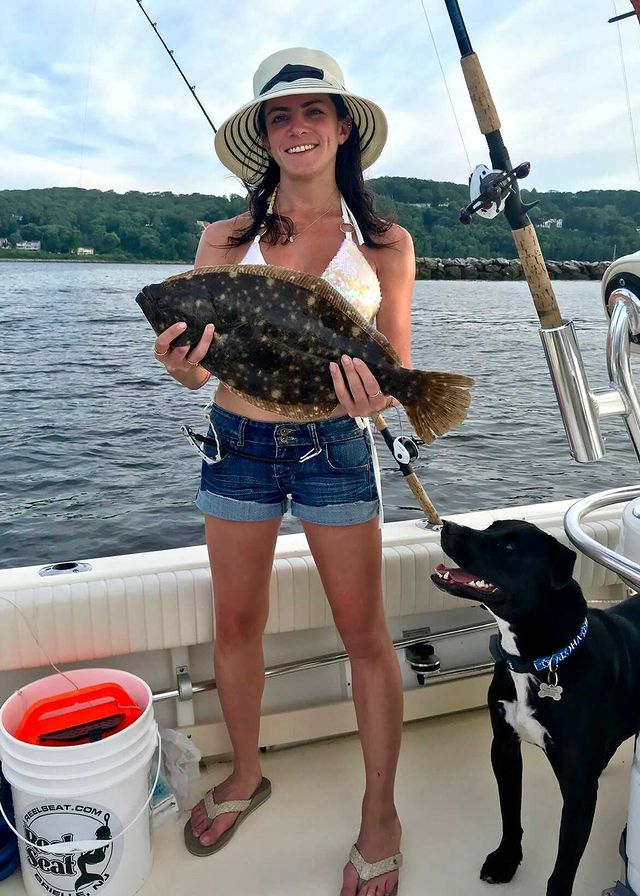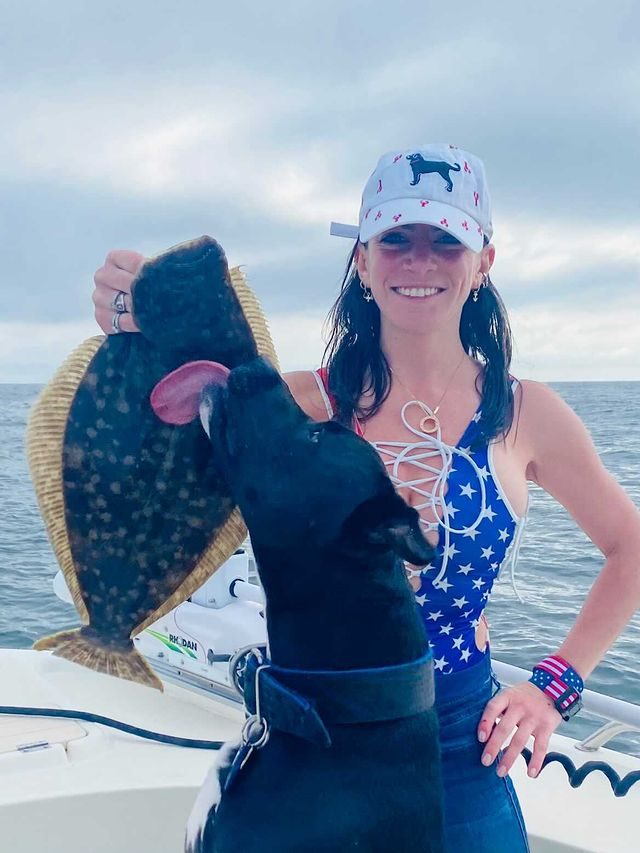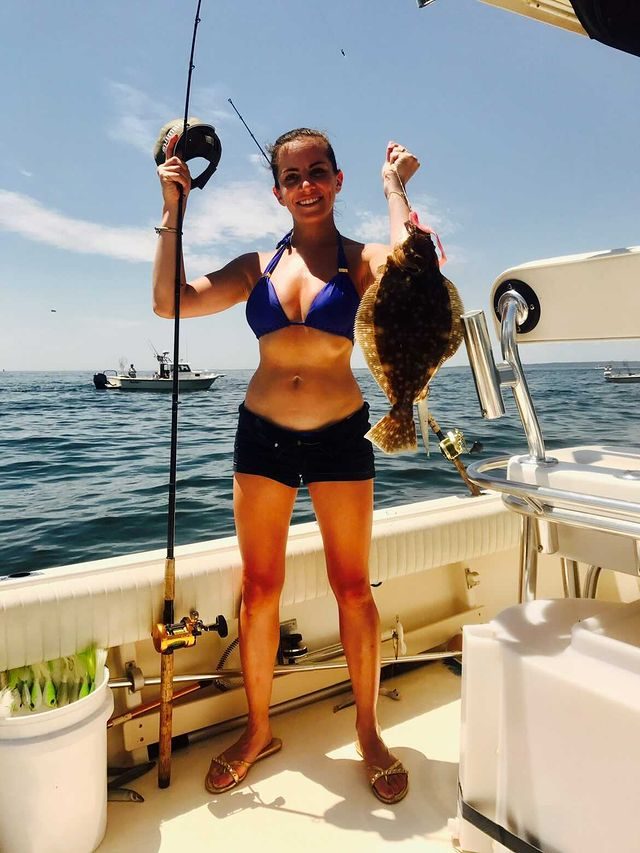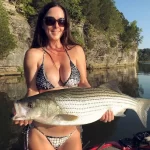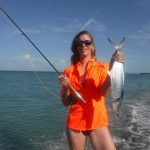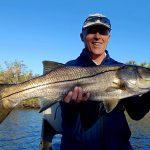How to Catch Flounder – Tips from a Pro Guide!
In this article, I will thoroughly discuss how to catch flounder. Flounder are a well known bottom fish in the “flatfish” family. In the northeast part of the country, anglers call them “fluke”. For all intents, they are the same fish with similar habits. Flounder fight hard, but are mostly prized by anglers for their snow white fillets!
I am a fishing guide on Siesta Key, Florida. I grew up in Maryland fishing Chesapeake Bay. Flounder were the top species up there, along with striped bass. Here in Florida, we catch Southern Gulf flounder. On my charters, we rarely target then specifically. Instead, we catch them using the standard angling techniques.
Special thanks to Johanna for the great pics and tech tips! Anglers can follow Johanna on Instagram
How to catch flounder and fluke
Often times, anglers can look at a fish and gain a clue to it’s behavior. One look at a flounder or fluke and an anglers can tell right away how it feeds. Flounder lie on the bottom, often partially buried in the sand, looking up. Both eyes are on the same side and the flounder has excellent camouflage.
Flounder and fluke often relate to structure. However, unlike other species, they will usually be found in the sand, just off the edge of the structure. Facing the current, flounder lie in wait, hoping to ambush unsuspecting prey as the tidal flow carries it past. Minnows and small bait fish are the preferred forage, but shrimp, crabs, and other crustaceans will not be refused either.
Best flounder and fluke fishing tackle
Anglers fishing for flounder and fluke can use a variety of tackle. If I had to choose one rod and reel combination, it would be a light conventional (or baitcasting) outfit. Casting will be limited, but is often not required. A 7′ to 7 ½’ medium rod with a fast action (stout butt, limber tip) and a matching reel spooled with 30 pound braided line is an excellent all round combination. This is the type of tackle that Johanna uses up in the Northeast.
Anglers can shop at Amazon for a Daiwa Black Gold reel and St Croix Triumph 7′ MF rod spinning combo in this link.
In Florida where I fish, spinning tackle is used more often. The flounder are smaller and the lures and baits that we use are fairly light. Spinning tackle is just a better choice for this application. I use a 7′ medium light rod with a 2500-3000 series reel and 20 pound braided line. It is basically the same rig used for most inshore saltwater fishing.
Best flounder an fluke fishing baits
As mentioned earlier, fluke and flounder love minnows! Small bait fish are their preferred forage. Some anglers use live minnows, though plenty of flounder are caught with dead or frozen baits. Live minnows are more trouble, they need to be caught or purchased and then kept alive. Frozen minnows are much more convenient and look alive in the water, especially in some current.
When I grew up years ago in Maryland, the crabs were so bad that using live minnows was frustrating. We primarily used strips of cut bait as it was more durable and we could shake the crabs off. That is an issue today, but not nearly as bad.
Shrimp are the top live bait in the southeast part of the country. They are abundant and available and every species will take them. Dead and frozen shrimp can be used as well. In the summer, I will also cast net sardines and flounder will certainly take them as well. Finally, mud minnows are hardy, easy to catch in a trap, and are very effective flounder fishing baits.
Cut bait is very effective when fishing for flounder and fluke! Squid is a universal and productive bait. It is usually but into long, slender strips, waving tantalizingly in the water. Any fresh caught fish that is legal can be cut into chunks or strips. Veteran anglers will cut a strip on the white side of the first legal flounder that they catch. This is a technique that Johanna often uses.
A recent addition to flounder and fluke fishing baits are commercially prepared baits. This is especially true for anglers surf fishing; many prefer them. The advantages are convenience and durability. These baits can be stored and are ready to use at all times. They also stay on the hook well. FishBites is probably the most popular example.
Flounder and fluke fishing rigs
Flounder and fluke baits need to be presented on the bottom. There are a variety of rigs that can be used, but the most common flounder and fluke rig is some variation of a sliding sinker, or Carolina rig. This rig has the advantage of fishing on the bottom while giving the bait room for movement. It also allows the fish to pick up the bait without feeling the resistance of the sinker.
The running line goes through the sinker, which is usually an egg sinker. A swivel stops the sinker. A leader is then tied on, followed by the hook. The leader is usually around 3′ long. A spinner can be added to increase flash and action. This rig works well when casting, bottom fishing on anchor, and drifting.
The other rig used most often is the high/low rig, also called a dropper rig or chicken rig. It is a standard rig that allows for multiple baits to be presented at varying depths. It is versatile and productive and is a great choice when a variety of species are available. It is perfect for drifting but can certainly be cast as well.
Sinker weight is very important. When drifting, the goal is to have the sinker just bouncing off the bottom. The weight will need to be adjusted as the strength of the tide changes. Anglers bottom fishing from an anchored boat want just enough weight to hit and hold the bottom.
Best flounder and fluke fishing lure
There really is only one artificial lure that anglers use to consistently use to produce fluke and flounder. That lure is the lead head jig. It can be presented right on the bottom, where flounder feed. A white bucktail jig with a strip of squid has produced many flounder over the years!
In the Northeast, anglers mostly drift fish with these lures. While drifting along, the jig is bounced up and then allowed to fall to the bottom. This is a very natural presentation. Jigs from 1-4 ounces are mostly used. White is an excellent color, though bright colors can produce in stained water. The jig can be tipped with cut bait or even a live minnow.
In Florida where I fish, and all along the Gulf Coast, the jig and grub rules. A ¼ ounce jig head with a 3” to 5” soft plastic bait works very well for flounder. We catch them in water that is not as deep and tides are weaker. Therefore, lighter jigs work well. For the most part,, they are cast out and retrieved, but can be vertically fished as well, particularly in passes.
Top flounder and fluke fishing spots
As with most saltwater fishing, the first order of business is locating fish. This is the case when flounder and fluke fishing as well. Anglers should start by understanding the local migration patterns of his or her particular area. Local bait shops and online forums are both excellent resources to use. Successful anglers keep moving until fish are located.
Flounder can be found on open sand and mud bottom. However, they will more often relate to some type of structure. This can be man made structure such as docks, bridges, wrecks, and jetties as well as natural ledges. Drifting works best over large areas while anchoring is best to fish smaller pieces of structure.
When anchoring, the best approach is to position the boat on the up-current side. This allows the bait to be presented back with the current, this is a natural looking presentation. This works well when fishing docks, bridges, small rock piles and ledges as well as other small areas or structures.
Drifting is a very productive flounder fishing technique! It allows anglers to thoroughly cover a large area while the bait remains in the strike zone the entire time. Sandy areas with ledges and depth changes are ideal spots to drift. Larger wrecks and ledges can also be drifted, though snagging the bottom can become an issue.
Surf fishing for flounder
Surf fishing for fluke and flounder is very popular. Anglers from Texas to New England catch fluke and flounder casting baits and jigs from the beach. The surf is a natural location for flounder to roam and feed. They are often caught fairly close to shore, in the first trough.
Most anglers surf fishing for flounder do so using cut bait. It stays on the hook better both during the cast and while fishing. Standard surf outfits work fine. One approach that I like to take when surf fishing ( I love surf fishing!) is to cast out a larger cut bait on the big rod and place it in a spike. Then, I work the trough with a jig for flounder and other species with a lighter spinning rod. This is a fun and productive one-two strategy.
Best Flounder and Fluke Fishing Tackle and Techniques
This article will cover flounder and fluke fishing tackle and techniques. Flounder and fluke are extremely popular inshore game fish. They are found along the coast from Texas to New England. Fluke and flounder are ambush predators, burying themselves in the sand to hide. Their markings are perfect camouflage. Anglers prize them for their tough fight, but more so for their tasty fillets! However, the proper tackle is required to be successful fishing for flounder.
Anglers fishing for flounder and fluke need two fishing rod and reel outfits. The first would be a medium spinning outfit and the second a medium light conventional rig. These two combos will cover virtually every flounder and fluke fishing situation. Anglers who surf fish can add a third rod and reel combination.
There is a bit of confusion about the differences in flounder and fluke. They are all in the “flatfish” family. In the south, southern gulf flounder are the predominant species. They have large mouths and are true predators. Up north, fluke are very similar. Same goes for Chesapeake Bay summer flounder. These all have both eyes on the left side. However, there is a winter flounder that has a small mouth and not nearly as aggressive. It has eyes on the right side.
No matter whether the southern gulf flounder or northern fluke is being sought, the techniques, baits, lures, and locations are quite similar. Flounder and fluke lie in the sand to ambush prey. However, they often relate to structure. This includes docks, bridges, rock piles, jetties, ledges, and more. Often times, the transition area where the sand meets the structure is a prime flounder and fluke holding spot.
Capt. Jim Klopfer is a fishing guide in Sarasota Florida. He grew up in Maryland, fishing the Chesapeake Bay ends tributaries. Capt. Jim has always loved surf fishing on the barrier island beaches of the Atlantic Ocean. He is sharing his tackle recommendations and fishing tips and this article with fellow anglers.
Best rods and reels for fluke and flounder fishing
Anglers fishing for flounder and fluke need two fishing rod and reel outfits. The first would be a medium spinning outfit and the second a medium light conventional rig. These two combos will cover virtually every flounder and fluke fishing situation. Anglers who surf fish can add a third rod and reel combination.
Medium spinning outfit
A medium spinning outfit is a versatile rod and reel combination. In fact, most anglers already own several. The same tackle used for schoolie striped bass or redfish will work fine. These lighter spinning outfits allow anglers to cast artificial lures in search of flounder and fluke. They can also be used for bottom fishing for average sized fish in shallow water.
A 7 foot medium rod with a “fast” action is the best choice. “Fast” action means a stout butt with a fairly limber tip. This allows for easy casting and detecting bites, but the strength to move a decent sized fish. It can be paired with a 3000 or 4000 series reel.
Here is a link to a good Daiwa/St.Croix combo that Capt Jim uses on his charters,
Anglers can shop at Amazon for a Daiwa Black Gold reel and St Croix Triumph 7′ MF rod spinning combo in this link.
“Fishing Lido Key is a participant in the Amazon Associates Program, an affiliate advertising program designed to provide a means for sites to earn advertising fees by advertising and linking to Amazon. As an Amazon Associate I earn from qualifying purchases.”
Medium light conventional outfit
The second rod and reel combination that every flounder and fluke angler needs is a light conventional outfit. These are used when fishing around heavy structure. Anglers will often times be fishing in heavy current and deeper water, which requires heavier sinkers. These light conventional outfits are much better for that application that spinning rigs are.
These types of conventional boat rods are generally a bit shorter. A 6 foot to 6 1/2 foot medium action rod with a 30 series reel is ideal for most inshore fluke and flounder fishing applications. This same outfit can be used for many other species such as blackfish, striped bass, bluefish, and more. It is a very versatile outfit and many experienced saltwater anglers already own several of these type rods.
Anglers can click this link to shop Amazon for Penn Squall conventional outfits
Surf fishing rod and reel
Surf fishing for flounder and fluke is very popular as well. Again, many anglers who surf fish for other species will already have an outfit that is fine for chasing flounder and fluke off of the beaches. These rods vary in length from 8 feet to 15 feet long. 10 to 12 feet is a good all-around size, matched with a 6000 to 8000 series reel.
Click this link to shop Amazon for a surf rod (10′ to 13″) and a Penn 6000 reel
Fishing line choices
There are three choices available to anglers when it comes to choosing fishing line for their reels. These are monofilament, fluorocarbon, and braided lines. Each has advantages and disadvantages. Monofilament line is an expensive but has stretch and a thicker diameter. Fluorocarbon line is better than monofilament but much more expensive.
Braided line is fairly expensive, yet lasts a long time, has zero stretch, has a thin diameter relative to strength, and is very sensitive. Most anglers today have gone to braided line. 20 pound test is a good size for inshore waters while anglers fishing heavier structure for larger fish offshore will bump it up to 40 pound or 50 pound test
Fluke and flounder fishing techniques
If there is one golden rule when it comes to fluke and flounder fishing, it is that the bait or lure needs to be presented on or very close to the bottom. As mentioned earlier, the species like to bury in the sand, then ambush bait fish and crustaceans as the tide washes them by. There are certainly times when flounder and fluke become very active and will feed quite a ways up off the bottom. However, this is the exception and not the norm.
Fluke and flounder are opportunistic feeders. They dine on a wide variety of forage. In fact, the list of things they won’t eat is much shorter than the list of things that they do. Small bait fish, shrimp, and crabs are fluke and flounder favorites. While they prefer their meals live, they are certainly not above scavenging off the bottom as well.
Flounder and fluke fishing with live and cut bait
Many anglers fish for flounder and fluke using natural bait, either live, frozen, or fresh cut. The top live bait in the Northeast is a live minnow. Somewhere near the South Carolina coast, live shrimp become equal in preference along with live minnows. The type of minnow that is productive varies depending on the geographic location. Anglers can buy minnows at local bait shops, though many anglers catch their own mud minnows and other minnows in traps. Every bait shop in the south carries live shrimp.
Strips of fresh cut bait work extremely well for fluke and flounder. The white, underside belly of just about any freshly caught fish (anglers should check their local regulations) cut into a long, 1 inch wide strip will catch fluke and flounder anywhere. Squid is very productive as well and is available at just about every bait shop. These strips of bait flutter seductively and look very natural in the water, while also providing scent and taste. Many anglers prefer cut bait over live minnows and situations where crabs are abundant and can become a nuisance.
Best flounder and fluke fishing baits
Frozen bait also works well for anglers fishing for fluke and flounder. It is a little less productive then either fresh cut or live bait. However, it is certainly much more convenient. The exception to this might be frozen shrimp, which will often catch as many fish as live shrimp. Surf anglers in particular tend to use frozen bait if for no other reason than the convenience factor.
Local bait and tackle shops are the best source for anglers fishing for fluke and flounder with live bait. They appreciate the business and are usually forthcoming with some good local information for anglers who make a purchase. Top baits include live minnows, frozen minnows, squid, live and frozen shrimp, clams, crabs, and frozen locally available fish such as mullet or mackerel.
Artificial lures catch fluke and flounder
There are a few artificial lures that are productive for flounder and fluke fishing as well. By far the most effective lure for the species is a jig. The reason for this is the manner in which a jig is presented. Jigs can be bounced right off of the bottom, kicking up little puff of sand as they move along. This very realistically mimics a wounded baitfish, crab, or shrimp.
White buck tail jigs have been catching flounder and fluke for many decades. This is the artificial lure that most anglers use when targeting flounder and fluke. These are versatile lures that can be worked in both shallow and deep water and are excellent when used drift fishing. Melissa uses S&S Bucktails, a local company. they manufacture an excellent lure of high quality with a strong hook.
Many anglers take the “best of both worlds” approach and combine the jig with live or cut bait. This is an extremely effective combination! The jig allows anglers precise presentation while the strip of cut bait or squid as well as a live minnow adds taste and scent.
Jig and grub combo produces
Anglers fishing the shallow inshore bays do well with the jig and grub combo. This is a lead head jig, usually around 1/2 ounce, with a soft plastic grub body trailer. The grub body can be of any length, with 4 inches being a good all-around size. The grub tails are manufactured to mimic both bait fish and crustaceans. They come in just about every color and shape imaginable! The Gulp line of baits is heavily scented and works extremely well on a jig head for fluke and flounder.
Fluke and flounder fishing locations
As with most fishing, locating fish is of the utmost importance. The best bait or lure has no chance if not presented in front of the fish. As mentioned above, flounder and fluke love the combination of structure and sand. The transition area where the rock or other cover turns into sand is a prime spot. This is true for artificial reefs, ledges, bridges, docks, and other structure.
Tides are crucial when it comes to fluke and flounder fishing, just as they are in most saltwater applications. While experience and local knowledge are indispensable, there are a few guidelines that anglers can adhere to. In the shallow backwater bays, high tides are usually best. In many cases, there simply is not enough water for the flounder and fluke to get up on the flats and feet. Flats adjacent to channels and deeper areas are generally best.
Many veteran fluke and flounder anglers prefer an outgoing tide. Flounder and fluke will stage on the edges of flats and drop-offs and ambush prey as the tide brings it to them. This is basically a conveyor belt of food! Tributaries and title creeks that enter larger rivers are prime spots. Passes and inlets are almost always more productive on the outgoing tide as well. The same holds true for bridges, where the points of land usually narrow a bit, increasing the current speed.
Anglers can either anchor or drift fish, depending on the situation. Large flats are almost always drifted, it is just more efficient. Smaller spots such as ledges and rock piles are best anchored. The best approach is to place the boat so that the bait can be presented just up-tide of the spot to be fished.
Terminal tackle and rigs
Anglers fishing for fluke and flounder will need some terminal tackle as well. These items include hooks, sinkers, leaders, and swivels. Most of veteran anglers tie up their own bottom fishing rigs. However, commercially available flounder rigs are available for those who do not want to tie their own.
There are many different flounder and fluke rigs. However, they really break down into two different types; fish finder or Carolina rigs, and high low or chicken rigs. While there are many variations, these are the two most popular ineffective rigs to present live and natural bait to fluke and flounder.
While most seasoned fluke and flounder anglers tie their own rigs, some prefer the convenience of commercially prepared rigs. There is nothing wrong with this! They can certainly save time and are quite convenient. Prepared rigs are available in a wide variety of hook sizes and leader lengths.
Sinkers
Anglers purchasing the best fluke and flounder fishing tackle have a surprising selection available to them when it comes to sinkers. Some have a unique design which allows them to walk over rocks and other structure without snagging. Anglers just starting out will do fine with a selection of egg sinkers and bank sinkers from 1 to 4 ounces. Heavy currents, deep water, and surf fishing may require even heavier weights.
Anglers will have to vary the weight of the sinker to match the local conditions. Tide strengths are constantly changing, and successful anglers adjust their sinker weights as well. The general rule of thumb is to use just the amount of weight to get to the bottom, and no more. Anglers who drift fish want the weight to be hitting the bottom but easily bouncing off.
Carolina rig and high/low rigs work well
The Carolina, or fish finder rig is a very popular and versatile rig. It consists of a sinker, usually X-shaped, with a hole through the center. The main line passes through this whole then a swivel is tied on. The swivel stops the sinker from moving any further and allows angler a place to attach the leader. A leader is then tied onto the other end of the swivel. It is usually between 3 feet and 5 feet long, followed by a hook.
This rig has several advantages. The hole in the sinker allows for a flounder or other fish to pick up the bait and move off with it, without feeling the resistance of the sinker. This can be important when fish are biting in a finicky manner. Also, the longer leader allows the sinker to sit on the bottom and the bait to undulate back in the current. This is attractive and will help elicit strikes. When drifting, the sinker will bounce off the bottom, kicking up puffs of sand, which attracts fish.
High/low rig
The high low or chicken rig is a very simple bottom fishing rig that works on fluke and flounder as a well as just about every bottom species. With this rig, the sinker is tied at the bottom and then several hooks are tied off of droppers at varying depths. This allows anglers to present multiple baits at multiple depths, to see what the fish want that day.
Both of these rigs can be used in just about any fluke or flounder fishing application. Each angler will certainly develop his or her favorite. However, these two rigs can be used when surf fishing, fishing from jetties or docks, bottom fishing from an anchored boat, and bottom fishing from a drifting boat.
Flounder fishing hooks
There are many different styles and sizes of hooks that anglers can choose when fishing for fluke and flounder. Once again, local bait shops are excellent sources of information and resources. Some anglers prefer long shank hooks. Many have recently gone to circle hooks, is a reduce fish mortality, almost always hooking the fish in the corner of the mouth. Some states actually require the use of circle hooks when bottom fishing. The standard live bait hooks that of been around forever work fine as well.
It is important to match the size of the hook to the size of the bait, not the size of the fish being targeted. Otherwise, using two small a hook in a large piece of bait will result in the bait blocking the hook, resulting in no hook set. Conversely, too large a hook with a smaller bait is an unnatural looking presentation, and may scare off a fish. Some flounder anglers put an in-line spinner in front of the hook to add some flash to the bait.
Leaders
Leaders are used between the mainline and the hook or jig and are an important piece of flounder and fluke fishing tackle. Fluorocarbon leader material is mostly used these days. Anglers using live or natural bait usually go with longer leaders, between 3 feet long and 5 feet long. Those who are casting jigs shorten up the leader to 24 inches or so as the longer leaders make casting difficult. The leader can be attached to the mainline using a small swivel or a line to line knot such as a double Uni-knot
Swivels
Swivels are basic pieces of terminal tackle that serves couple of purposes. They are used as weight stops on Carolina rigs. Swivels allow for easy attachment of leaders. They also help reduce significantly line twist. Anglers should purchase quality ball bearing swivels, this really is not the place to save a couple of dollars. A selection of #6, #8, and #10 black swivels is all that is required.
In conclusion, this article on how to catch flounder and fluke will help anglers be more successful when chasing these hard-fighting and incredibly tasty inshore saltwater game fish!
